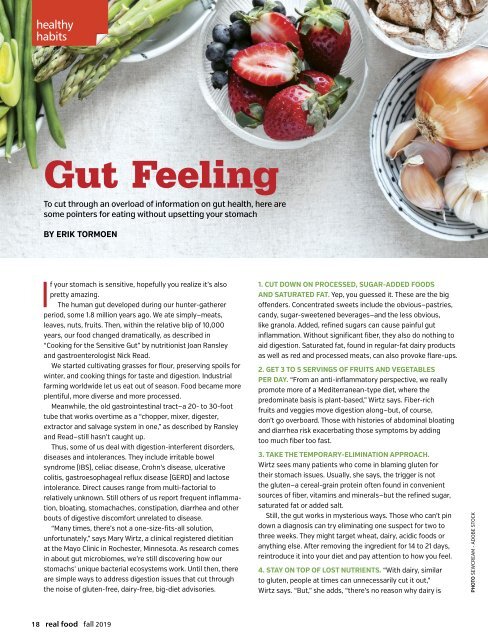Create successful ePaper yourself
Turn your PDF publications into a flip-book with our unique Google optimized e-Paper software.
healthy<br />
habits<br />
Gut Feeling<br />
To cut through an overload of information on gut health, here are<br />
some pointers for eating without upsetting your stomach<br />
BY ERIK TORMOEN<br />
If your stomach is sensitive, hopefully you realize it’s also<br />
pretty amazing.<br />
The human gut developed during our hunter-gatherer<br />
period, some 1.8 million years ago. We ate simply—meats,<br />
leaves, nuts, fruits. Then, within the relative blip of 10,000<br />
years, our food changed dramatically, as described in<br />
“Cooking for the Sensitive Gut” by nutritionist Joan Ransley<br />
and gastroenterologist Nick Read.<br />
We started cultivating grasses for flour, preserving spoils for<br />
winter, and cooking things for taste and digestion. Industrial<br />
farming worldwide let us eat out of season. <strong>Food</strong> became more<br />
plentiful, more diverse and more processed.<br />
Meanwhile, the old gastrointestinal tract—a 20- to 30-foot<br />
tube that works overtime as a “chopper, mixer, digester,<br />
extractor and salvage system in one,” as described by Ransley<br />
and Read—still hasn’t caught up.<br />
Thus, some of us deal with digestion-interferent disorders,<br />
diseases and intolerances. They include irritable bowel<br />
syndrome (IBS), celiac disease, Crohn’s disease, ulcerative<br />
colitis, gastroesophageal reflux disease (GERD) and lactose<br />
intolerance. Direct causes range from multi-factorial to<br />
relatively unknown. Still others of us report frequent inflammation,<br />
bloating, stomachaches, constipation, diarrhea and other<br />
bouts of digestive discomfort unrelated to disease.<br />
“Many times, there’s not a one-size-fits-all solution,<br />
unfortunately,” says Mary Wirtz, a clinical registered dietitian<br />
at the Mayo Clinic in Rochester, Minnesota. As research comes<br />
in about gut microbiomes, we’re still discovering how our<br />
stomachs’ unique bacterial ecosystems work. Until then, there<br />
are simple ways to address digestion issues that cut through<br />
the noise of gluten-free, dairy-free, big-diet advisories.<br />
1. CUT DOWN ON PROCESSED, SUGAR-ADDED FOODS<br />
AND SATURATED FAT. Yep, you guessed it. These are the big<br />
offenders. Concentrated sweets include the obvious—pastries,<br />
candy, sugar-sweetened beverages—and the less obvious,<br />
like granola. Added, refined sugars can cause painful gut<br />
inflammation. Without significant fiber, they also do nothing to<br />
aid digestion. Saturated fat, found in regular-fat dairy products<br />
as well as red and processed meats, can also provoke flare-ups.<br />
2. GET 3 TO 5 SERVINGS OF FRUITS AND VEGETABLES<br />
PER DAY. “From an anti-inflammatory perspective, we really<br />
promote more of a Mediterranean-type diet, where the<br />
predominate basis is plant-based,” Wirtz says. Fiber-rich<br />
fruits and veggies move digestion along—but, of course,<br />
don’t go overboard. Those with histories of abdominal bloating<br />
and diarrhea risk exacerbating those symptoms by adding<br />
too much fiber too fast.<br />
3. TAKE THE TEMPORARY-ELIMINATION APPROACH.<br />
Wirtz sees many patients who come in blaming gluten for<br />
their stomach issues. Usually, she says, the trigger is not<br />
the gluten—a cereal-grain protein often found in convenient<br />
sources of fiber, vitamins and minerals—but the refined sugar,<br />
saturated fat or added salt.<br />
Still, the gut works in mysterious ways. Those who can’t pin<br />
down a diagnosis can try eliminating one suspect for two to<br />
three weeks. They might target wheat, dairy, acidic foods or<br />
anything else. After removing the ingredient for 14 to 21 days,<br />
reintroduce it into your diet and pay attention to how you feel.<br />
4. STAY ON TOP OF LOST NUTRIENTS. “With dairy, similar<br />
to gluten, people at times can unnecessarily cut it out,”<br />
Wirtz says. “But,” she adds, “there’s no reason why dairy is<br />
PHOTO SEWCREAM - ADOBE STOCK<br />
18 real food fall <strong>2019</strong>

















